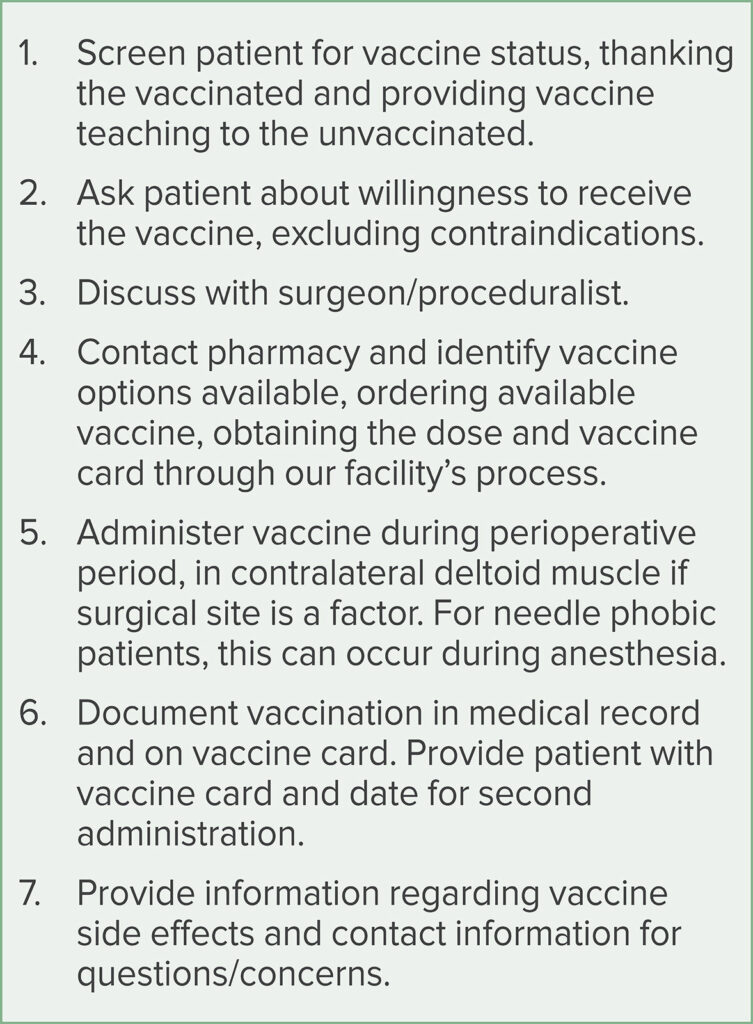As of November 13, 2021, the COVID-19 pandemic has infected more than 253 million people worldwide causing more than 5 million deaths. At the time of this writing, the United States alone has had 46 million cases, resulting in 762,000 deaths.1 The available COVID-19 vaccines have had a positive impact on disease severity and population survival,2 yet only 59% of the U.S. population that is eligible for the vaccine is fully vaccinated at the time this article was authored.1 The estimated total cost of this pandemic is 16 trillion USD.3 A variety of reasons exist for the low rates of vaccination in the United States, which do not necessarily relate to individual refusal. Such reasons can include needle phobia, fear of health care settings, lack of access to vaccination sites, government distrust, long-term safety concerns, and fear of deportation for illegal immigrants.
The preoperative period may be an excellent opportunity to provide COVID-19 vaccine education and offer vaccine administration. Patients may be receptive to education from their perioperative care providers and the convenience of vaccination during their hospital stay. At present, there are no prior reports of COVID-19 vaccination during the perioperative period and no published guidelines. The Center for Disease Control recommends each patient speak to their health care providers about vaccination in relation to surgical or other procedures.4 The risks of administration of vaccines during the perioperative time period and the benefits of vaccination must be weighed, taking into account the potential immune response to vaccination and effect on surgical healing.5
Table 1: Protocol for Perioperative COVID-19 Vaccination
In collaboration with the Anesthesia and Surgical Teams, Nursing and the OR Pharmacy, here at the Massachusetts General Hospital, the authors developed a protocol (Table 1) for perioperative COVID-19 vaccination. To date five patients (Table 2) have actively sought COVID-19 vaccination and have been provided a first dose during the perioperative period. During the one-month period between September 15, 2021, to October 15, 2021, in caring for 94 patients, the authors encountered eight unvaccinated patients during regular anesthesia practice. Among this cohort, 50% of the unvaccinated patients were open to receiving vaccination. We have been able to accommodate each of these requests with the availability of vaccine doses at the time of request in our central pharmacy. No untoward side effects have been reported after vaccine administration at the present time. Vaccine cards were filled out and distributed to patients with instructions given to assist with scheduling second vaccine appointments in collaboration with primary surgical teams, patients, and caregivers.
Table 2: Patient Characteristics and Reasons for Perioperative Vaccination
Vaccination administration during anesthetic care may be an effective way to improve vaccination compliance, patient, and population wellness. While the number of unvaccinated patients presenting for surgery is unknown, it is likely to approximate the 40% of unvaccinated patients in the US population overall and even be higher in regions with lower vaccination rates. The patients at MGH who have received these doses had varying reasons to not yet be vaccinated and all were grateful to receive their first dose.
Next steps for the initiative include extending the program more widely across the institution and its affiliates, facilitating second dose administration, and monitoring rates of success. A number of questions remain unanswered including whether there are differences in vaccination efficacy based on surgical procedure type, patient characteristics, and the optimal timing of administration during the perioperative period. Such questions warrant study on a larger scale.
Despite large population-wide vaccine efforts, a significant number of people remain unvaccinated during the COVID-19 pandemic. A prime opportunity for perioperative providers to join together to improve the health of our unvaccinated patients and our society with vaccination is present. We encourage institutions worldwide to join in these efforts by establishing their own vaccination programs.
Celeste Day, MS, CRNA, is a senior nurse anesthetist at Massachusetts General Hospital, Boston, MA.
Edward A Bittner MD, PhD, MSEd, is an associate professor of Anesthesia, Harvard Medical School, Massachusetts General Hospital, Boston, MA. He is associate editor of the APSF Newsletter.
The authors have no conflicts of interest.
References
- Johns Hopkins University of Medicine Coronavirus Resource Center. https://coronavirus.jhu.edu/. Last accessed November 13, 2021.
- Centers for Disease Control and Prevention COVID-19 Vaccine Effectiveness. https://www.cdc.gov/coronavirus/2019-ncov/vaccines/effectiveness.html. Last accessed November 13, 2021.
- Cutler DM, Summers LH. The COVID-19 Pandemic and the $16 Trillion Virus. JAMA. 2020;324:1495–1496. https://jamanetwork.com/journals/jama/fullarticle/2771764.
- Centers for Disease Control and Prevention COVID-19 Vaccines and Other Procedures. https://www.cdc.gov/coronavirus/2019-ncov/vaccines/expect/other-procedures.html. Last accessed November 13, 2021.
- Lin C, Vazquez-Colon C, Geng-Ramos G, Challa C. Implications of anesthesia and vaccination. Paediatr Anaesth. 2021;31:531–538.


 Issue PDF
Issue PDF PDF
PDF
